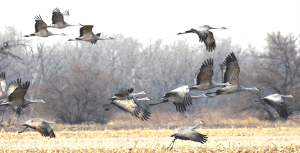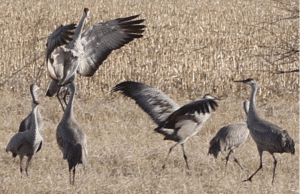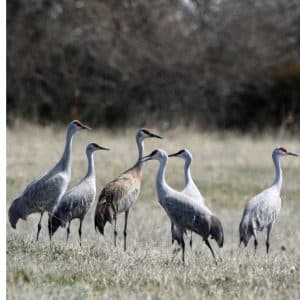Blog - General, Common Birds, Featured
About Sandhill Cranes

ABOUT SANDHILL CARNES – publication and photos by Wild Bird Habitat
The Sandhill Crane has one of the longest fossil histories of any existing bird, with the oldest dating back 2.5 million years. This is almost twice as old as the remains of most current living bird species. But even more amazing are the fossilized remains found in Nebraska of what is believed to be the early prehistoric ancestor of the Sandhill Cranes which date back over 10 million years. With the Platte River dating back a young 10,000 years, these early cranes were sharing a savannah type habitat with the North American rhinoceros, camel, and elephant that have long been extinct.
LIVE CRANE CAM – Watch tens of thousands of Sandhill Cranes on the Platte River in the evening as they return to the river to roost starting at 6pm CST and again before dawn at 6am CST as they leave the river to feed with prime viewing through the month of March

The Sandhill Cranes survived and adapted as the prairies developed some 14,000 years ago. They witnessed the prehistoric mammals replaced by the American Bison, Pronghorn Antelope, and elk. And in just the last 150 years have further adapted to the influences of man along with the introduction of cattle, row crops, and sprawling urban communities.
The common name, Sandhills Crane, is derived from its relationship with the Platte River surrounded by the Nebraska sandhills. This region is an important annual migratory stopover for up to 1 million Sandhill Cranes. 15% of that population are intermediate, or Sandhill Cranes which nest in Canada, 5 % are Greater Sandhill Cranes, and the balance are Lesser Sandhill Cranes. The Sandhill Cranes that pass through the heart of Nebraska known as the Central Flyway, winter in Texas, New Mexico, and Mexico. The normal arrival date in Nebraska on their way north is late February.
The crane population along the Platte River peaks by late March, and by the second week of April, other than a few stragglers, they have made a mass exodus to the breeding grounds. As the Greater Sandhill Cranes settle down to nest in western Minnesota and Manitoba, the Canadian, or intermediate cranes head for central Canada from the Rockies to Hudson Bay. It is the Lesser Sandhill Crane that migrate into the high Arctic nesting across Northern Canada and Alaska with more than 100,000 of them crossing the Bering Strait to nest in Eastern Siberia
When the cranes reach the Platte River on their way north, they will spend approximately 29 days increasing their body fat by a quarter of their weight. That will provide the energy needed to complete the migration and begin nesting. Cranes are omnivores. 90% of their diet during their stay in the Platte Valley is corn with about 10% consisting of invertebrate insects, worms and crustaceans. Prior to the consumption of vast quantities of waste corn, they feed on today during their stay, before agriculture shaped the plains the cranes fattened up on a variety of starchy wetland tubers. Today only 10% of those natural wetlands exist having been replaced by corn and soybeans. 
After a day of feeding in the fields surrounding the Platte River, the cranes begin to move toward the river as the sun lowers on the horizon. By dusk tens of thousands of Sandhill Crane began landing in the shallows of the river to roost for the night. This provides a respectful degree of protection from predators. As many as 12 to 15 thousand cranes can congregate along a single half mile stretch of the river to spend the evening.
Sandhill Cranes are very large birds with long thin legs and necks. They stand 3 to 4 feet in height, and have a wingspan of 6 feet when full grown. Their weight varies between 8 to 12 pounds. They are pretty hard to miss seeing. The feathers are mostly grayish but the shade of gray can vary widely. The forehead has a bright red patch that is one of the most distinguishing features of the bird along with white cheeks. The red patch on the forehead is actually bare skin. Sometimes they may appear to have a reddish-brown appearance. This is because Sandhill Cranes preen themselves by rubbing mud on their feathers. Maybe it helps control feather mites or other parasites that thrive among large groups of birds. Maybe it is unintentionally gathered in their bill while foraging for food. None-the-less, the color may vary depending if the mud is brown or red.
Their bills and feet of a Sandhill Crane are important tools. A crane’s bill is very sharp and sturdy being useful when probing frozen soil. The edges are serrated to grasp slippery food like worms, tadpoles, or snakes. Not only is the bill used for preening, it can also double as a weapon. The feet and legs of a crane work in conjunction with the beak whether foraging for food or defending itself. The foot has three long toes with claws on the end. These claws are very sharp and can be used for scratching in dirt to find food as well as protection. When a crane is threatened, it will use its wings to maintain its balance and then jump up and strike at the attacker with its feet.
The eggs and the young of the Sandhill Cranes are preyed on by raccoons, crows, hawks, eagles, owls, ravens, wolves, coyotes, and foxes. The adult Sandhill Cranes are threatened by hunters in states which allow it, and habitat loss.
Its hard to believe in this age of media someone has not seen documentaries and images or heard about the Wildebeest migration across the grassy plains of Africa. Yet right here in the central part of North America, along a 65 mile stretch of the Platte River in the middle of the Great Pains called Nebraska, is a migration of wildlife that rivals any on the planet. The migration of the Sandhill Cranes.
When the cranes head for the river to roost, they arrive in lose flocks scattered across the sky. As they land on the water it appears as if a large feathered raft is being created. But in the morning as the sun rises a nervous anticipation spreads through these massive groups of cranes scattered up and down the river. Then, all of a sudden as if on cue, thousands of cranes ascend into the air with a unified shattering sound of calls and wing beats. It is repeated up and down the river until the sky becomes a shadowy mass of cranes spreading out to select a field where they will spend most the next 8 to 10 hours feeding, loafing, and interacting between family members and with their neighbors.
While in the fields feeding, they can be seen performing their well known “dance of the cranes.” Mated pairs will bow to each other with outstretched wings, leaping high off the ground. They may grab sticks or corn stubble and repeatedly toss it into the air during these displays. This courtship is believed to strengthen the pair bond between mates. Sandhill Cranes are monogamous, remaining together for life which can be well over 25 years. But Sandhill Cranes are confronted by many obstacles.

LIVE CRANE CAM – Watch the cranes on the Platte River before dusk at 6pm CST and before dawn at 6am CST
